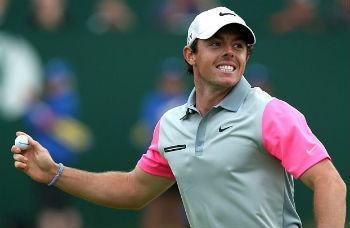The Power of Distraction
Don’t you get bored? What do you think about the whole time? What do you do in the winter? How do you find the time? How much do your shoes cost? No, but seriously, don’t you get bored?
Do these questions sound familiar, runners? Of course they do. Because these are the questions I ask all my friends who happen to be golfers.
Golf, you guys. I just don’t get it. Golf is like the human version of fetch, only more tedious. No, it’s worse than that. It’s like fetch and looking for your car keys all mashed up in one hideously inconvenient activity. Golf cart or walk? Oh, I don’t know… Would you like to simulate lugging baggage around an airport terminal? Or would you like the repeated sensation of running back to your car because you forgot something?
For years I have tried, to no avail, to grasp why this game might appeal to sentient beings. The only possible conclusion is that golf clubs distract golfers from the vapid Weltschmerz of the game. No, not clubs like country clubs, but the actual golf sticks that golf players use to hit the golf balls. I mean, imagine golf without golf clubs.
 [Guy in tee box picks up golf ball and throws it as far as he can.]
[Guy in tee box picks up golf ball and throws it as far as he can.]
[Guy chases ball down fairway, picks it up, and throws it pretty far, but not as far as the first time.]
[Guy chases ball, picks it up, and just kinda lobs it.]
[Guy chases ball, picks it up, and then… gently! tenderly! careful! rolls it into a teeny-tiny hole in the ground.]
[Guy repeats this seventeen more times.]
In other words, if you take away the golf clubs, you still have golf. Just without the distraction.
And while the Golf Club Theory doesn’t necessarily explain the allure of golf, it does shed some light on why golfers are so quick to spend hundreds of dollars on carbon fiber drivers with names like Big Bertha and Son, You’d Better Get a Scholarship.
The golf clubs, the distraction, are everything.
(Before all you golfers out there unleash your fury on me, know that it’s all in good fun, ‘mkay?)
Anyway, back to the topic at hand: distractions.
Yesterday, I was listening to NPR’s Fresh Air during my run. The radio hostess with the mostess, Terry Gross, interviewed science writer Jo Marchant about her new book, Cure: A Journey Into The Science of Mind Over Body. The book explores the mind’s ability to heal the body and manage pain. Of course, as a distance runner, I was intrigued. I mean, mind over body? That’s our language, our Holy Grail, our iChing, our pièce de résistance.
Marchant explained that our bodies have a physical response to positive elements—from kind words to hopeful thoughts to nurturing touch—in the same way they have a physical response to negative elements, such as stress. A positive response in the mind can trigger a correlated positive response in the body, which in turn combats pain and disease. A simple example would be the placebo effect: even if people in a study are taking sugar pills, if they believe the pills are healing them, they are more likely to see positive results. In fact, Marchant said, pharmaceutical companies often struggle to beat the results of placebos.
Furthermore, Marchant mentioned numerous studies that are being conducted to examine the power of the mind beyond the placebo effect. How quickly do symptoms abate in patients when a doctor spends forty-five minutes with them instead of twenty? What improvements do patients see if their doctors deliver their care sympathetically versus stoically? The results are fascinating.
But there was one slice of the interview that particularly caught my attention. Marchant talked about awareness of pain and the power of distraction. She said the mind has a limited capacity for attention, and if one thing is demanding a great amount of focus, there is less attention “left over” for other things. The fewer distractions we have, she said, the more aware of pain we become. But a distraction—better yet, an immersive distraction—can lessen pain exponentially. Because our minds just don’t have room for it.
As I listened to Marchant, I immediately began to think of long runs and hard workouts with Jake, and how his presence served as my “distraction” from the pain. Some of the fastest miles I’ve run have been with him by my side, chatting away about high school cross country or arguing why High Violet is The National’s best album, not Trouble Will Find Me. I also began to think about marathons I’ve run—more specifically, the ends of marathons I’ve run—and how I would have paid a million dollars for a grand distraction at mile twenty-three.
I once heard this quote—I don’t know where, but I love it—“The greatest asset an athlete can have is a body with nothing left to give and a mind that believes otherwise.” A mind that believes otherwise. There is so much strength and power in that phrase. And yet, now, after years of distance running, I’d like to attach my own little addendum:
“… or a mind that is very, very distracted.”
As humorous as that amendment is, I think it, too, is powerful in its own way. Pain may be a bully, but it isn’t sovereign. It doesn’t have to control us. We don’t have to surrender the moment it shows up. I like knowing I have two options when it comes to dealing with the pain of the late stages of a race or workout: face it head on or get busy thinking about something else. It’s like your two options when you have to endure eighteen holes of golf.
Cart or walk?

Amy L. Marxkors is the author of The Lola Papers: Marathons, Misadventures, and How I Became a Serious Runner and Powered By Hope: The Teri Griege Story. Click here to receive Amy's weekly article via email.
Connect With Us
See the latest from Fleet Feet St. Louis